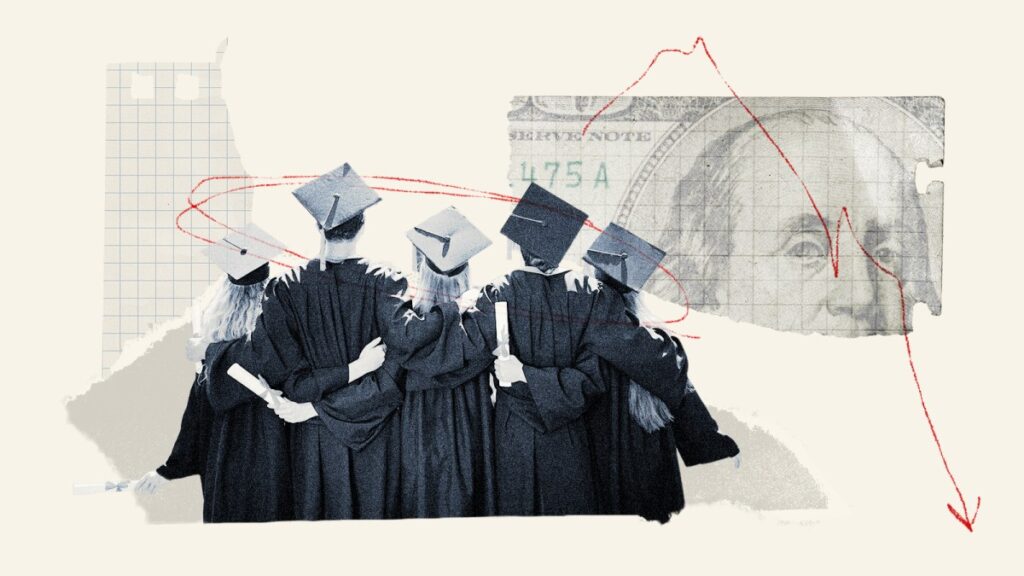President Trump’s thesis is clear: many of America’s elite universities, and especially Harvard, are hotbeds of left-wing radicalism that have failed to tackle antisemitism on campus.
He has said so repeatedly. However, it is not just the universities’ leaders who are subject to his ire: in a Truth Social post this week he wrote of how just under a third of Harvard’s students were “from FOREIGN LANDS … some not at all friendly to the United States”.
Then he ordered US embassies to stop scheduling visa interviews for all prospective foreign students, who will now have their social media profiles vetted, according to leaked White House plans published by Politico.
What you need to know
But who are America’s international students — and where do they come from?
How many foreign students does America have?
There were 1.1 million international students in the US in the past academic year, making up about 6 per cent of the country’s total student population. The pace of growth has been rapid — the figures have doubled since 2006.
About 80 per cent are at university, while the rest are enrolled in optional practical training, a scheme that allows foreign students to work for a limited period after their studies finish.
Which university has the most international students?
Trump’s most high-profile spat has been with Harvard, perhaps the most famous American university.
His administration, which accuses the university leadership of liberal bias, has suspended more than $2.2 billion worth of grants and contracts involving Harvard and has threatened to go further. (What’s next?)
This academic year, Harvard had 7,000 international students, making up more than a quarter of the student body. That is a lot — but it does not make the top ten of universities with the largest cohort of foreign students.
No 1 spot goes to New York University, where half of the 61,000 students come from abroad. The total has increased from 10,000 in 2013 to 27,000 in 2024.
Other colleges high up the list include Columbia, also in New York, and Berkeley in California.
Half of the country’s international students are in six states: California, New York, Texas, Massachusetts, Illinois and Pennsylvania.
Universities are notably more concentrated in places that vote Democrat rather than Republican. Kamala Harris beat Trump in 19 of the 50 states, plus the District of Columbia, in last year’s presidential election — and these states, which are generally more densely populated in general, account for 54 per cent of the country’s international students.
Lots of the others are in blue pockets of Trump-voting states, such as Austin, home of the University of Texas, and Philadelphia, home of the University of Pennsylvania and its Wharton School of Business, whose most famous alumnus is Trump.
Where do America’s foreign students come from?
Students come from every corner of the world to study in America but some places are better represented than others.
Almost three quarters hail from Asian countries, and by far the most students come from India and China, which combined make up 54 per cent of the total.
The world’s two most populous countries are followed by South Korea, Canada, Taiwan, Vietnam and Nigeria. There were 10,500 British students enrolled in US universities in 2023-24, which is about 1 per cent of all students.
President Xi of China spent time in the US in 1985 on a study programme, and his daughter Xi Mingze studied in the US under a pseudonym
XINHUA/SHUTTERSTOCK/REX
DIA DIPASUPIL/GETTY IMAGES
Relatively few come from the countries that Trump has historically considered hostile to the US — such as Iran, Libya, Somalia, Sudan, Syria and Yemen, all countries on which he imposed travel restrictions in his first term. While there were 12,400 Iranian students in the US in the past academic year, only 1,500 came from the other five countries combined.
Trump’s claims of antisemitism on campuses stemmed from pro-Palestinian protests amid the Israel-Gaza conflict. A total of 466 foreign students come from the Palestinian territories.
Do many foreign students stay for good?
It is far easier to come to study in the US than it is to legally stay afterwards.
The US has a cap of 85,000 H-1B visas, which are awarded to companies hiring graduate foreigners in “specialty occupations” where there is a shortage of Americans capable of doing the job. Of this total, 20,000 are reserved for people with advanced degrees.
Far more than this apply each year, so the spots are allocated by lottery. In reality numbers are somewhat higher because of “cap exempt” visas, but most of those who study in the US leave afterwards.
These visas are mostly issued to immigrants who have studied subjects such as computing and engineering, where it is easier for employers to argue that there are skills shortages in the US, and the importance of these jobs, given America’s world-leading role in technology.
This is also reflected in what foreign students study — mostly science, technology, engineering and mathematics.
While Trump rails against the universities he sees as inherently opposed to him and his party, educational institutions are making the case that foreign students bring in cash and do the sort of highly skilled labour that creates jobs for Americans, as well as immigrants.
According to Nafsa, an association of international educators, foreign students contributed $43.8 billion to the US economy in the past academic year and supported 380,000 jobs. It includes money flowing into areas such as student accommodation and hospitality, as well as more directly into tuition fees, for example.



